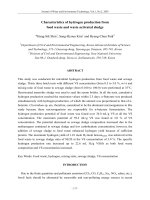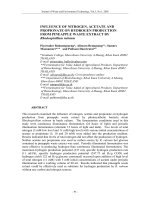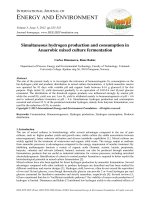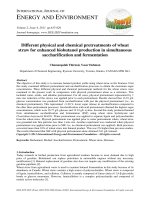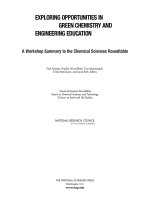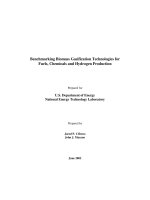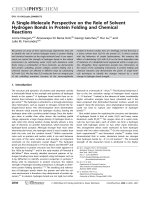nuclear hydrogen production handbook green chemistry and chemical engineering
Bạn đang xem bản rút gọn của tài liệu. Xem và tải ngay bản đầy đủ của tài liệu tại đây (17.34 MB, 898 trang )
Green Chemistry and Chemical Engineering
NUCLEAR
HYDROGEN
PRODUCTION
H A N D B O O K
Edited by
Xing L. Yan
Ryutaro Hino
6000 Broken Sound Parkway, NW
Suite 300, Boca Raton, FL 33487
270 Madison Avenue
New York, NY 10016
2 Park Square, Milton Park
Abingdon, Oxon OX14 4RN, UK
an informa business
www.taylorandfrancisgroup.com
K10540
w w w . c r c p r e s s . c o m
NUCLEAR HYDROGEN
PRODUCTION
H A N D B O O K
Yan
Hino
ISBN: 978-1-4398-1083-5
9 781439 810835
90000
“e fact that nuclear hydrogen production is now almost reality is not widely known. is
handbook gives us the most thorough review of the state of art of nuclear hydrogen, which could
be used not only for scientific and technological communities, but for the potential users to assess
its reality.”
—Dr. Toru Ogawa, Japan Atomic Energy Agency
“…this book is exceptional as a textbook or primer guide for professional researchers.”
—Dr. Yoshimi Okada, Chiyoda Corporation
Written by two leading researchers from the world-renowned Japan Atomic Energy Agency, the
Nuclear Hydrogen Production Handbook is an unrivalled overview of current and future pros-
pects for the effective production of hydrogen via nuclear energy. Combining information from
scholarly analyses, industrial data, references, and other resources, this handbook illustrates hydro-
gen’s versatility and potential both as a clean, sustainable energy carrier (e.g., fuel for vehicles and
power generators) and feedstock material for industry (agriculture, oil, chemical, and steel, etc.).
Packed with details about the science, engineering, and production involved in nuclear hydrogen
generation, this handbook presents:
China, Korea, the US and the EU, among others
electrolysis of steam and biomass gasification
exchangers, and thermochemical iodine–sulfur process construction and operations
Far exceeding the limited introductory detail offered in other books on the topic, this book offers
an all-encompassing international perspective on nuclear hydrogen production. Addressing a wide
range of pertinent technologies, scientific trends, and technical details, this resource will be a useful
tool for readers at all levels of understanding.
NUCLEAR HYDROGEN PRODUCTION
H A N D B O O K
Nuclear
Hydrogen
Production
H a n d b o o k
GREEN CHEMISTRY AND CHEMICAL ENGINEERING
Series Editor: Sunggyu Lee
Ohio University, Athens, Ohio, USA
Proton Exchange Membrane Fuel Cells: Contamination and Mitigation Strategies
Hui Li, Shanna Knights, Zheng Shi, John W. Van Zee, and Jiujun Zhang
Proton Exchange Membrane Fuel Cells: Materials Properties and Performance
David P. Wilkinson, Jiujun Zhang, Rob Hui, Jeffrey Fergus, and Xianguo Li
Solid Oxide Fuel Cells: Materials Properties and Performance
Jeffrey Fergus, Rob Hui, Xianguo Li, David P. Wilkinson, and Jiujun Zhang
Efficiency and Sustainability in the Energy and Chemical Industries:
Scientific Principles and Case Studies, Second Edition
Krishnan Sankaranarayanan, Jakob de Swaan Arons, and Hedzer van der Kooi
Nuclear Hydrogen Production Handbook
Xing L. Yan and Ryutaro Hino
Nuclear
Hydrogen
Production
H a n d b o o k
Edited by
Xing L. Yan
Ryutaro Hino
CRC Press
Taylor & Francis Group
6000 Broken Sound Parkway NW, Suite 300
Boca Raton, FL 33487-2742
© 2011 by Taylor and Francis Group, LLC
CRC Press is an imprint of Taylor & Francis Group, an Informa business
No claim to original U.S. Government works
Printed in the United States of America on acid-free paper
10 9 8 7 6 5 4 3 2 1
International Standard Book Number-13: 978-1-4398-1084-2 (Ebook-PDF)
This book contains information obtained from authentic and highly regarded sources. Reasonable efforts have been
made to publish reliable data and information, but the author and publisher cannot assume responsibility for the valid-
ity of all materials or the consequences of their use. The authors and publishers have attempted to trace the copyright
holders of all material reproduced in this publication and apologize to copyright holders if permission to publish in this
form has not been obtained. If any copyright material has not been acknowledged please write and let us know so we may
rectify in any future reprint.
Except as permitted under U.S. Copyright Law, no part of this book may be reprinted, reproduced, transmitted, or uti-
lized in any form by any electronic, mechanical, or other means, now known or hereafter invented, including photocopy-
ing, microfilming, and recording, or in any information storage or retrieval system, without written permission from the
publishers.
For permission to photocopy or use material electronically from this work, please access www.copyright.com (http://
www.copyright.com/) or contact the Copyright Clearance Center, Inc. (CCC), 222 Rosewood Drive, Danvers, MA 01923,
978-750-8400. CCC is a not-for-profit organization that provides licenses and registration for a variety of users. For
organizations that have been granted a photocopy license by the CCC, a separate system of payment has been arranged.
Trademark Notice: Product or corporate names may be trademarks or registered trademarks, and are used only for
identification and explanation without intent to infringe.
Visit the Taylor & Francis Web site at
and the CRC Press Web site at
vii© 2011 by Taylor & Francis Group, LLC
Contents
Foreword ix
Preface xi
Editors xiii
Contributors xv
Section I Hydrogen and Its Production fromNuclear Energy
1. The Role of Hydrogen in the World Economy 3
Ryutaro Hino, Kazuaki Matsui, and Xing L. Yan
2. Nuclear Hydrogen Production: An Overview 47
Xing L. Yan, Satoshi Konishi, Masao Hori, and Ryutaro Hino
Section II Hydrogen Production Methods
3. Water Electrolysis 83
Seiji Kasahara
4. Steam Electrolysis 99
Ryutaro Hino, Kazuya Yamada, and Shigeo Kasai
5. Thermochemical Decomposition of Water 117
Seiji Kasahara and Kaoru Onuki
6. Conversion of Hydrocarbons 155
Karl Verfondern and Yoshiyuki Inagaki
7. Biomass Method 165
Jun-ichiro Hayashi
8. Radiolysis of Water 177
Ryuji Nagaishi and Yuta Kumagai
Section III Nuclear Hydrogen Production Systems
9. Water Reactor 191
Charles W. Forsberg, Kazuyuki Takase, and Toru Nakatsuka
viii Contents
© 2011 by Taylor & Francis Group, LLC
10. High-Temperature Gas Reactor 211
Xing L. Yan, Ryutaro Hino, and Kazutaka Ohashi
11. Sodium Fast Reactor 293
Takamichi Iwamura and Yoshiyuki Inagaki
12. Gas Fast Reactor 317
Yoshiyuki Inagaki and Takamichi Iwamura
13. Fluoride Salt Advanced High-Temperature Reactor 329
Per F. Peterson and Edward D. Blandford
14. STAR-H2: A Pb-Cooled, Long Refueling Interval Reactor for
HydrogenProduction 347
David C. Wade
15. Fusion Reactor Hydrogen Production 377
Yican Wu and Hongli Chen
Section IV Applied Science and Technology
16. High-Temperature Electrolysis of Steam 417
James E. O’Brien, Carl M. Stoots, and J. Stephen Herring
17. Thermochemical Iodine–Sulfur Process 461
Kaoru Onuki, Shinji Kubo, Nobuyuki Tanaka, and Seiji Kasahara
18. The Hybrid Sulfur Cycle 499
Maximilian B. Gorensek and William A. Summers
19. Nuclear Coal Gasication 547
Karl Verfondern
20. Nuclear Steam Reforming of Methane 555
Yoshiyuki Inagaki and Karl Verfondern
21. Hydrogen Plant Construction and Process Materials 571
Shinji Kubo and Hiroyuki Sato
22. Nuclear Hydrogen Production Process Reactors 603
Atsuhiko Terada and Hiroaki Takegami
23. Nuclear Hydrogen Production Plant Safety 639
Tetsuo Nishihara, Yujiro Tazawa, and Yoshiyuki Inagaki
24. Nuclear Hydrogen Plant Operations and Products 661
Hiroyuki Sato and Hirofumi Ohashi
Contents ix
© 2011 by Taylor & Francis Group, LLC
25. Licensing Framework for Nuclear Hydrogen Production Plant 679
Yujiro Tazawa
Section V Worldwide Research and Development
26. Hydrogen Production and Applications PrograminArgentina 695
Ana E. Bohé and Horacio E.P. Nassini
27. Nuclear Hydrogen Production Development in China 725
Jingming Xu, Ping Zhang, and Bo Yu
28. European Union Activities on Using Nuclear Power for Hydrogen Production 739
Karl Verfondern
29. HTTR-IS Nuclear Hydrogen Demonstration Program in Japan 751
Nariaki Sakaba, Hirofumi Ohashi, and Hiroyuki Sato
30. Nuclear Hydrogen Project in Korea 767
Won Jae Lee
31. NGNP and NHI Programs of the U.S. Department ofEnergy 777
Matt Richards and Robert Buckingham
32. International Development of Fusion Energy 795
Satoshi Konishi
Section VI Appendices
Appendix A: Chemical, Thermodynamic, and Transport Properties of Pure
Compounds andSolutions 801
Seiji Kasahara
Appendix B: Thermodynamic and Transport Properties of Coolants for
NuclearReactors Considered for Hydrogen Production 837
Seiji Kasahara
xi© 2011 by Taylor & Francis Group, LLC
Foreword
Two enabling technologies for nuclear hydrogen production existed as early as the 1950s.
Soon after President Dwight D. Eisenhower of the United States of America spoke about the
Atoms for Peace plan to the United Nations General Assembly in 1953, ground was broken for
the construction of Shippingport, the rst large-scale nuclear power generating plant in the
world. The light water reactor went online in 1957, and hundreds more civilian reactors were
to follow. At the time electrolysis had been in practice for decades. However, direct combina-
tion of the two able to mass produce hydrogen (a manufacturing material in high demand)
was not sought after in the market because of plentiful and more affordable oil and natural
gas (the hydrocarbon fuels), off which hydrogen can be stripped via a chemical route.
Today, the world demand for the fossil fuels has risen fourfold and the price for them
more than doubled. Their proven reserves are estimated to run dry in another 40 and
60years for oil and natural gas, respectively, at current paces of use. On the day of my writ-
ing this foreword, the United Nations Climate Change Conference (COP15) gathered 192
nations in Copenhagen, Denmark for negotiation of an international agreement to limit
air-borne emission of climate-altering carbon dioxide gas, a product of fossil fuel con-
sumption. Many came to this meeting with a pledge of deep emission cuts by 2020 includ-
ing 17% below the 2006 national level in the United States, 25% in Japan and Russia, and
30% in the European Union below the 1990 levels. The threat of climate change is too great
to people all around the world and a global accord to mitigate it is imperative.
The Japan Atomic Energy Agency has recently formulated a Nuclear Energy Vision 2100
that proposes how nuclear energy may contribute to a low-carbon society. Relying on a sus-
tainable mix of fast and thermal neutron spectrum ssion reactors and future magnetic
inertial fusion reactors, our Vision seeks, together with renewable energy and energy ef-
ciency saving, to reduce carbon emission by 25% and 90% below the 1990 level in the coming
decade and by the end of the century, respectively, in Japan (our nation is now 16% above that
level). In particular, nuclear hydrogen is called upon to replace the majority of fossil fuels
used today in the transportation sector through fuel cell engines and in the manufacturing
sector through alternative industrial processes such as direct hydrogen reduction of iron
ore for steelmaking. In my ofcial capacities in JAEA and AESJ, I am advised by scientists,
notably Dr. Xing Yan and Dr. Ryutaro Hino who have over 50 years of collective experience,
in the eld.
I nd that scientists here and abroad have invented more technologies to produce nuclear
hydrogen since the dawn of peacetime atomic energy. Besides electrolysis, there are ther-
mochemical, hybrid chemical, thermal reforming, and radiolysis methods combined with
several designs of nuclear reactors and systems and with minimal or zero carbon emis-
sion. The details of the sciences, engineering, and production applications of these tech-
nologies are included in the Nuclear Hydrogen Production Handbook. Through development,
in which signicant public and private interests are currently engaged, these technologies
are expected to be put to wide uses, to serve humanity in a low-carbon world.
Dr. Hideaki Yokomizo
Executive Director, Japan Atomic Energy Agency
President, Atomic Energy Society of Japan
xiii© 2011 by Taylor & Francis Group, LLC
Preface
The expansion of the world’s population and economy resulted in a 20-fold rise in the use
of fossil fuels during the twentieth century. Usage continues to rise and is expected to
double the current level by 2050. Neither the trend nor the degree of the present depen-
dence on fossil energy is considered sustainable since the resources of oil, gas, and coal are
known to be nite and because intensive use risks grave consequences of climate change.
Major alternative fuels are needed on a scale that can keep humanity’s development con-
tinual in this century and beyond, while steering clear of unwarranted climatic effects.
Hydrogen is such an alternative fuel because it can be used in places where fossil fuels
areused without emitting the global warming carbon dioxide and is produced in small or
large quantities from a variety of resources.
Section I of this handbook introduces the economy-wide roles of hydrogen and the
approaches that can be taken to producing it from nuclear energy. The current primary
uses of hydrogen in the production of ammonia fertilizers and fuel oils will only grow
as agriculture steadily increases with the world’s population and as continual volatility
in crude oil supply creates incentives to converting widely available and low-priced coal,
tar sands, and oil shale into synfuel. It is estimated that increasing the use of hydrogen
in hydrocracking by 10-fold from the current 4 million tonnes annually would allow the
United States to liquefy enough domestic coal to end oil import. The U.S. manufacture of
fuel from coal would be economical if oil is priced at US$35 per barrel. Oil has averaged
twice as much in the last 5 years.
Fuel cells are entering markets. Japan calls for 15 million fuel cell vehicles (FCVs) by 2030
and a full replacement of the 75 million strong eet on its roads today within the century.
The National Research Council of the U.S. National Academies sees a more aggressive
American deployment scenario of 25 million FCVs by 2030 and 200 million (80% of the
light-duty eet) by 2050, which would need 110 million tonnes of hydrogen fuel annually.
Manufacturers will also demand hydrogen to increase sustainability. The present global
consensus looks to cut CO
2
emission by 50–80% below the 1990 levels by mid-century. To
emerge from the potential applications and policy initiatives is a world economy based on
widely available, affordable, and clean hydrogen.
Hydrogen must be produced for it is rarely found alone on the Earth. Half of the current
50million tonnes annual global production of hydrogen is from natural gas and the rest
from oil and coal. Section II describes the basics of the methods with which hydrogen can
be produced from nuclear energy with reduced or no fossil feedstock. Incorporating these
methods into nuclear reactors to form practical nuclear production systems is discussed
in Section III. The resulting systems produce hydrogen through electrolysis of water,
nuclear heated steam reformation of hydrocarbons, high-temperature electrolysis, and
thermochemical splitting of the water molecule. Section IV reports on applied science and
technology and there readers are able to nd substantial analyses and data on the present
state of the art of nuclear hydrogen production.
The Generation IV International Forum has selected six nuclear reactor concepts for
future development that can be licensed, built, and operated to supply economical and
reliable electricity, hydrogen, or both while satisfactorily addressing nuclear safety,
waste, proliferation, and public acceptance. Section V introduces worldwide up-to-date
xiv Preface
© 2011 by Taylor & Francis Group, LLC
development and commercialization programs on nuclear reactor systems and associ-
ated hydrogen production systems. Section VI presents the properties of the relevant
substances.
We would like to thank the large number of the world’s leading experts in research insti-
tutions, universities, and industries for their contributions that comprise this volume.
Xing L. Yan
Ryutaro Hino
xv© 2011 by Taylor & Francis Group, LLC
Editors
Xing L. Yan received his PhD from the Massachusetts
Institute of Technology in 1990. He participated in the
United States Department of Energy’s development
program on the modular high-temperature gas-cooled
reactor and he contributed to the Energy Research Center
of the Netherlands’ program for small high-temperature
reactor cogeneration plant designs. He was a consultant to
nuclear reactor vendor industries in the United States,
Japan, and France. Since 1998, he has joined the Japan
Atomic Energy Agency’s design and technology
development program for a new generation of GTHTR300C nuclear reactor plants for gas
turbine power generation and water-splitting hydrogen production.
Ryutaro Hino received his PhD from the University of
Tokyo in 1983. He has since joined the Japan Atomic Energy
Agency and currently leads the nuclear hydrogen program
on high-temperature reactors. He is the only researcher in
the Japan Atomic Energy Agency who has experience in all
three leading nuclear hydrogen production methods under
worldwide development: steam reforming of methane,
high-temperature electrolysis, and thermochemical water
splitting. He was awarded the 2007 Prize of the Atomic
Energy Society of Japan for his contribution to the successful
development of new ceramic heat exchangers used for
high-temperature thermochemical hydrogen production.
xvii© 2011 by Taylor & Francis Group, LLC
Contributors
Edward D. Blandford
Department of Nuclear Engineering
University of California
Berkeley, California
Ana E. Bohé
National Atomic Energy Commission
Bariloche, Argentina
Robert Buckingham
General Atomics
San Diego, California
Hongli Chen
Institute of Plasma Physics
Chinese Academy of Sciences
Anhui, China
Charles W. Forsberg
Department of Nuclear Science
andEngineering
Massachusetts Institute of Technology
Cambridge, Massachusetts
Maximilian B. Gorensek
Savannah River National Laboratory
U.S. Department of Energy
Aiken, South Carolina
Jun-ichiro Hayashi
Institute of Materials Chemistry
andEngineering
Kyushu University
Kasuga, Japan
J. Stephen Herring
Idaho National Laboratory
U.S. Department of Energy
Idaho Falls, Idaho
Ryutaro Hino
Japan Atomic Energy Agency
Ibaraki, Japan
Masao Hori
Nuclear Systems Association
Tokyo, Japan
Yoshiyuki Inagaki
Japan Atomic Energy Agency
Ibaraki, Japan
Takamichi Iwamura
Japan Atomic Energy Agency
Ibaraki, Japan
Seiji Kasahara
Japan Atomic Energy Agency
Ibaraki, Japan
Shigeo Kasai
Power Systems Company
Toshiba Corporation
Tokyo, Japan
Satoshi Konishi
Institute of Advanced Energy
Kyoto University
Kyoto, Japan
Shinji Kubo
Japan Atomic Energy Agency
Ibaraki, Japan
Yuta Kumagai
Japan Atomic Energy Agency
Ibaraki, Japan
Won Jae Lee
Korea Atomic Energy Research Institute
Daejeon, Korea
Kazuaki Matsui
The Institute of Applied Energy
Tokyo, Japan
Ryuji Nagaishi
Japan Atomic Energy Agency
Ibaraki, Japan
xviii Contributors
© 2011 by Taylor & Francis Group, LLC
Toru Nakatsuka
Japan Atomic Energy Agency
Ibaraki, Japan
Horacio E.P. Nassini
National Atomic Energy
Commission
Bariloche, Argentina
Tetsuo Nishihara
Japan Atomic Energy Agency
Ibaraki, Japan
James E. O’Brien
Idaho National Laboratory
U.S. Department of Energy
Idaho Falls, Idaho
Hirofumi Ohashi
Japan Atomic Energy Agency
Ibaraki, Japan
Kazutaka Ohashi
Energy and Environmental System
Research Center
Fuji Electric Holdings Co., Ltd.
Kawasaki, Japan
Kaoru Onuki
Japan Atomic Energy Agency
Ibaraki, Japan
Per F. Peterson
Department of Nuclear
Engineering
University of California
Berkeley, California
Matt Richards
General Atomics
San Diego, California
Nariaki Sakaba
Japan Atomic Energy Agency
Ibaraki, Japan
Hiroyuki Sato
Japan Atomic Energy Agency
Ibaraki, Japan
Carl M. Stoots
Idaho National Laboratory
U.S. Department of Energy
Idaho Falls, Idaho
William A. Summers
Savannah River National Laboratory
U.S. Department of Energy
Aiken, South Carolina
Kazuyuki Takase
Japan Atomic Energy Agency
Ibaraki, Japan
Hiroaki Takegami
Japan Atomic Energy Agency
Ibaraki, Japan
Nobuyuki Tanaka
Japan Atomic Energy Agency
Ibaraki, Japan
Yujiro Tazawa
Japan Atomic Energy Agency
Ibaraki, Japan
Atsuhiko Terada
Japan Atomic Energy Agency
Ibaraki, Japan
Karl Verfondern
Research Center Juelich
Institute for Energy Research
Juelich, Germany
David C. Wade
Argonne National Laboratory
U.S. Department of Energy
Argonne, Illinois
Yican Wu
Institute of Plasma Physics
Chinese Academy of Sciences
Anhui, China
Jingming Xu
Institute of Nuclear and New Energy
Technology
Tsinghua University
Beijing, China
Contributors xix
© 2011 by Taylor & Francis Group, LLC
Kazuya Yamada
Power Systems Company
Toshiba Corporation
Tokyo, Japan
Xing L. Yan
Japan Atomic Energy Agency
Ibaraki, Japan
Bo Yu
Institute of Nuclear and New Energy
Technology
Tsinghua University
Beijing, China
Ping Zhang
Institute of Nuclear and New Energy
Technology
Tsinghua University
Beijing, China
© 2011 by Taylor & Francis Group, LLC
Section I
Hydrogen and Its Production
fromNuclear Energy
3© 2011 by Taylor & Francis Group, LLC
1
The Role of Hydrogen in the World Economy
Ryutaro Hino, Kazuaki Matsui, and Xing L. Yan
CONTENTS
1.1 Introduction 4
1.2 Hydrogen Properties 4
1.2.1 Hydrogen Isotopes 4
1.2.2 Physical Property 5
1.2.3 Chemical Property 6
1.2.4 Fuel Property 6
1.3 Traditional Hydrogen Applications 9
1.3.1 Ammonia Production 9
1.3.2 Petroleum Industry 10
1.3.3 Other Applications 11
1.4 Developing Hydrogen Applications 12
1.4.1 Development Programs of Applications and Policies 14
1.4.1.1 The United States 14
1.4.1.2 Japan 15
1.4.1.3 Europe 16
1.4.1.4 Worldwide 17
1.4.2 Transportation 17
1.4.2.1 Hydrogen Internal Combustion Engine Vehicles 17
1.4.2.2 Hydrogen Fuel Cell Vehicles 18
1.4.3 Power Generation 23
1.4.3.1 Utility Power Generation 23
1.4.3.2 Distributed Power Generation 26
1.4.4 Power and Heat Cogeneration 27
1.4.5 Iron and Steel Making 29
1.4.5.1 Hydrogen-Assisted Blast Furnace 30
1.4.5.2 Hydrogen Direct Reduction Furnace 31
1.5 Hydrogen Production 35
1.5.1 General Requirements 35
1.5.2 Chemical Reforming 36
1.5.3 Electrolysis 39
1.5.4 Thermochemical Process 41
1.6 Summary and Conclusions 44
References 45
4 Nuclear Hydrogen Production Handbook
© 2011 by Taylor & Francis Group, LLC
1.1 Introduction
Hydrogen, though the most abundant element in the luminous universe (helium comes in
distant second), is rarely found on Earth. The reasons are both that the smallest atom easily
diffuses to the outer space and that it is chemically active and readily forms compounds
with other elements. Notable compounds containing hydrogen include organic matters
and water. In fact, the oceans are the largest terrestrial reservoir of hydrogen.
This handbook concerns the subject of producing hydrogen by splitting it off various
chemical compounds including water and describes a range of processes and technolo-
gies, from the conventional to the contemporarily researched in the world, designed to
convert the primary nuclear energy into chemical energy of product hydrogen.
Hydrogen can be produced from nuclear energy in such manners and quantities that
sufce it as a clean and widely available fuel to substitute the fossil fuel uses across the
economy, including transportation, stationary and mobile power generation, and energy
sources for business, hospital, and home, while meeting substantial demand for hydrogen
in sustainable industrial production such as for chemicals and steels.
1.2 Hydrogen Properties
1.2.1 Hydrogen Isotopes
Having atomic number 1, hydrogen is the lightest chemical element. The hydrogen atom is
composed of a single electron orbiting a nucleus and can be visualized by the Moon as the
electron and the Earth as the nucleus. The electron orbital, which is about a hundred thou-
sand times as large as the size of the nucleus, is formed by the Coulomb interaction between
the negatively-charged electron and the positively-charged nucleus.
Hydrogen has three known natural occurring isotopes with the standard atomic weight
of 1.00794 u. They include protium
1
H, deuterium
2
H (also represented by D), and tritium
3
H (T). At standard conditions of temperature and pressure, these isotopes naturally form
stable diatomic molecular gases, for example, H
2
or HT.
Protium is most common with an abundance of 99.9885% of the natural hydrogen atoms.
The isotope, also known as ordinary hydrogen, contains a single proton and no neutron in
the nucleus and its atomic mass is 1.007825032 u. The isotope is basically not radioactive.
Water primarily is made of molecules of protium with oxygen, namely, H
2
O. So are organ-
isms of hydrogen with carbon, for example, methane, CH
4
. This handbook is concerned
with the production of this isotope and the ordinary hydrogen gas.
Adding a neutron into the nucleus of protium makes what is known as deuterium. Therefore,
the latter approximately doubles the atomic mass of the former. Deuterium has a natural
abundance of 0.0115% and is nonradioactive. The chemical compound of deuterium and oxy-
gen, D
2
O, is known as heavy water. Natural water on the Earth like the oceans contains a
small concentrate of deuterium. As a result, heavy water or deuterium can be obtained from
water for practical uses. Heavy water is used as a neutron moderator and coolant in some
nuclear ssion reactors. Deuterium is also useful as a partial fuel for nuclear fusion reactors.
Tritium populates the nucleus with two neutrons and one proton, and weighs about three
times as heavy as a protium atom. When combined with oxygen, it forms tritiated water,
T
2
O and more often HTO. Unlike the other isotopes of hydrogen, tritium is radioactive with
The Role of Hydrogen in the World Economy 5
© 2011 by Taylor & Francis Group, LLC
ahalf-life of 12.31 years and decays to
3
He through β decay with release of electron energy
(18.61 keV) and emission of an antineutrino. Tritium occurs naturally as a result of the cos-
mic radiation of atmospheric gases, mainly through fast neutron (>4 MeV) spallation of
atmospheric nitrogen (
14
N +
1
n →
12
C +
3
H). Because of the relatively short half-life, only
traces of tritium occurring in this way exist at any moment and accounts approximately
4 per 10
15
natural hydrogen atoms in the atmosphere. The tritium population is much
lessconcentrated in natural water. However, tritium may be produced in several ways
including neutron activation of lithium-6 and neutron capture by deuterium in nuclear
reactors. Tritium is considered an indispensable part of fuel for nuclear fusion energy.
Although deuterium and tritium are sought to provide a practical atomic fuel for fusion
energy, they are not explicitly required for hydrogen used as chemical fuel and ordinary
manufacturing feedstock. This book is thus not concerned with the specic subject of
producing the heavier isotopes of hydrogen.
1.2.2 Physical Property
Hydrogen has the second-lowest boiling point (–252.78°C) of all substances, after only
helium (−268.92°C), at atmospheric pressure. Pressurization can do little to raise the boiling
point of hydrogen. These properties make it difcult, but not impractical, to store hydro-
gen as liquid. As a result, hydrogen as an automotive fuel has been stored more often as a
pressurized gas than a cryogenic liquid in on-board fuel tank. Alternatively, hydrogen
may be stored and resupplied via hydrogenation and dehydrogenation of various types of
hydrides such as saline (e.g., NaH), covalent (e.g., NaAlH
4
), and interstitial (e.g., Pd) hydrides.
The density of hydrogen gas (H
2
) is 0.08375 kg/m
3
and specic volume is 11.940 m
3
/kg at
standard conditions of 20°C and 101.325 kPa. To estimate density ρ (and specic volume
being inverse of density) in the modest range of temperature and pressure from the
standard conditions uses the ideal gas law, ρ = P/RT, where the specic gas constant of
hydrogen R = 4124.45 J/kg K.
At high pressures, hydrogen gas deviates signicantly from the thermodynamic
behavior of an ideal gas and the density of hydrogen is actually 2.9% less at 5 MPa and
5.7% less at 10 MPa than predicted by the ideal gas law. This is called compressibility fac-
tor, which can be measured directly. The equation of state for real (nonideal) hydrogen gas
is recently reported [1]. Hydrogen gas is often stored onboard a vehicle as a fuel in a pres-
sure range of 35–70 MPa. At a temperature of 20°C and accounting compressibility factor,
the density of hydrogen is 23.651 kg/m
3
and specic volume is 0.042282 m
3
/kg at 35 MPa
while these values are 39.693 kg/m
3
and 0.025193 m
3
/kg at 70 MPa. The density of liquid
hydrogen is 71.107 kg/m
3
and the specic volume is 0.014063 m
3
/kg at −253°C and 101.325
kPa near the normal boiling point.
Hydrogen gas has the smallest molecular size compared to all other gases, and can dif-
fuse through materials that are impermeable to other gases. Metals or nonmetals exposed
constantly to hydrogen may become brittle. Containers of hydrogen gas require deliberate
techniques of material and construction, and are an ongoing development issue.
Hydrogen is generally not toxic, but poses a risk of asphyxiation if inhaled. Because
hydrogen gas is odorless, tasteless, and invisible to human beings, it is difcult to detect
a leak of hydrogen. A leak will not spread but rise quickly due to the highly buoyant
nature of hydrogen in atmospheric air. Gaseous hydrogen has a specic gravity of 0.0696
at 20°C and 1 atm and is thus approximately 7% the density of air. Liquid hydrogen has
a specic gravity of 0.0708 at the boiling point (−282.78°C) and is about 7% the density of
water. A leak of liquid hydrogen, which is 59 times heavier than air, would evaporate
6 Nuclear Hydrogen Production Handbook
© 2011 by Taylor & Francis Group, LLC
and rise quickly in ambient air due to the low boiling point and specic gravity of
hydrogen.
1.2.3 Chemical Property
Hydrogen forms a vast array of compounds with carbon. Millions of hydrocarbons are
known as organic components. Natural gas and crude petroleum are among them. They
originated biologically, and many transformed into being over time.
Hydrogen forms chemical or inorganic components with other elements. Water is the
chemical component that hydrogen forms with oxygen. Like hydrogen, pure water is col-
orless, odorless, and tasteless. It is neither acidic nor basic. Water is the most abundant
component on the Earth’s surface. Interestingly, water is a renewable source of hydrogen
fuel. The use of hydrogen fuel in a combustor or fuel cell forms the same amount of water
used to produce it, and no carbon dioxide or pollutants. Hydrogen fuel holds the promise
of a clean energy carrier to the future.
Hydrogen can react with organic and chemical components. This property contributes to
a broad range of manufacturing activities. Hydrogenation is used to rene or sweeten
organic components in petroleum and food processes. Ammonia fertilizers are made by
the chemical reaction of hydrogen with the source of nitrogen gas in the air. Hydrogen as
an effective reducer is used to remove oxygen (forming H
2
O) from metal oxides to produce
metals. It is also used to chemically remove unwanted impurities from industrial products.
Some major manufacturing applications of hydrogen are reviewed later in this chapter.
Finally, hydrogen can also form compounds with other elements and components
through ionic bounding. By taking on a partial positive charge, hydrogen binds to more
electronegative elements such as halogens (e.g., F, Cl, Br, and I). Similarly, by taking on a
partial negative charge, it forms compounds with more electropositive materials such as
metals and metalloids, and these are known as various designs of hydrides, some of which
are interesting hydrogen storage media.
1.2.4 Fuel Property
Hydrogen gas is inammable with a wider range of ignition concentrations in air than
other conventional fuels (see Table 1.1). Hydrogen burns in air with a pale blue ame. If
burned in pure oxygen, hydrogen ames emit ultraviolet light and are nearly invisible, as
observed behind hydrogen–oxygen rocket engines. The hydrogen–oxygen combustion
follows the exothermal chemical reaction:
2H
2
+ O
2
→ 2H
2
O + ΔH (1.1)
The enthalpy, ΔH, of the combustion product is 285.83 kJ/mol (higher heating value or
HHV) and 241.82 kJ/mol (lower heating value or LHV) for the conditions of 25°C and
101.325 kPa. The mass-based enthalpy values are given in Table 1.1 for the HHV and LHV
as dened therein. Water is produced in combustion as steam, and therefore the LHV rep-
resents the amount of energy usable to do work. Hydrogen easily has the highest energy
content per mass of not only the fuels in Table 1.1 but all combustion fuels. Multiplying
energy content per mass by density, whose values are given in Table 1.1, gives energy den-
sity of a fuel. Because its density is so small, hydrogen has the lowest energy density
(10.074 MJ/m
3
LHV and 11.915 MJ/m
3
HHV) of all combustion fuels. Methane gas has
morethan three times the energy content of hydrogen gaseous fuel while gasoline has
nearly 3000 times greater energy density than hydrogen.
